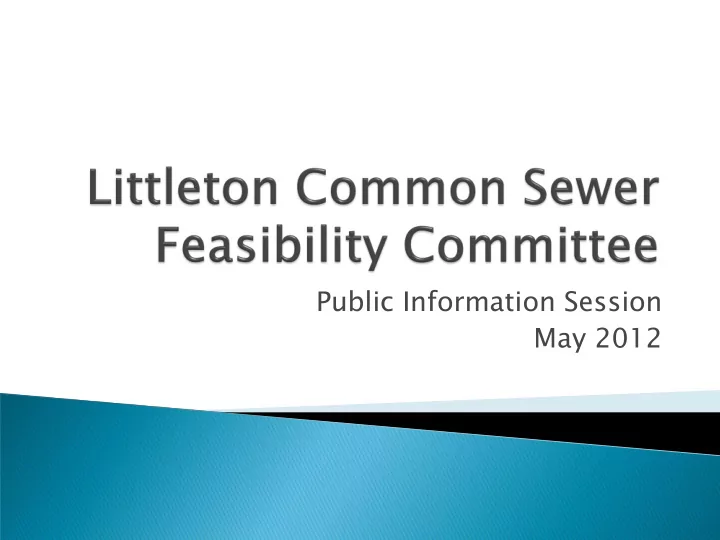

Public Information Session May 2012
Created and charged at May 3, 2010 Town Meeting Purpose Four guidelines driving the study ◦ Sustainability of a clean water supply ◦ Economics ◦ Environmental ◦ Consistency with community character Study Area ◦ Village Common District ◦ Village Overlay District
• Provide sewering to enable growth In the VCD/VOD • Create affordable limited sewering that does not require funding via the wider community (user based) • Limited sewering prevents sprawling growth and maintains Littleton’s character
Treatment plant design (phasing) Distribution Design Economics of sewer district Life cycle costs Power generation
Ted Doucette, Chair - Board of Selectmen Megan Ford, Vice-chair – Citizen at Large Peter Cassinari – Board of Health Joe Collentro - Permanent Municipal Building Committee Richard Crowley – Planning Board Savas Danos – LELWD Stephen Jahnle – Citizen at large Donald MacIver – Citizen at large Ken Smith – Citizen at large Warren Terrell – Citizen at large
Charles River Watershed Association (CRWA) Natural Systems Utilities (NSU) - Grant obtained by CRWA (from Barr) $100,000 - CRWA in kind work $25,000
Approved at town meeting $50,000 Expenses to date ◦ Natural Systems Utilities $28,500 ◦ Admin/misc $500 ◦ Soil testing (budget) $10,000 ◦ Balance/other expenses (SP details, permits) $11,000
Definition: Systems that are traditionally used to collect municipal wastewater in gravity and/or pressure sewers and convey it to a central primary treatment plant, before discharge on receiving surface waters. Large capital expenses are bonds paid by the general fund - all taxpayers contribute whether or not they are served by the system. Typical process with conventional sewer: Target sewer district/area Calculate maximum flows and capacity Preliminary Design Design system for full build out and capacity Apply to State for Permit Town Meeting approve funding Bid documents and bid award System construction System operational and property connections
Chelmsford ◦ $165 million ◦ 3.1 million GPD discharged out of district South Acton ◦ Cost being borne by tax base ◦ Full capacity built - actual flow underutilized Tewksbury ◦ Cost shifted to all tax payers ◦ Discharged out of district
Smart Sewer Overview ◦ Wastewater is a resource ◦ Smart Growth Enhances economic growth Reduces overall energy Increases short term affordability Optimizes benefits to environment
Economic Component of Smart Sewers Sewer districts Installed in response to growth/demand Focuses development Reduces risk of conventional sewer Reduced upfront capital Installed in response to demand Paid by users Betterment User fees
Reducing carrying costs by using technologies that are affordable at small scale and then installing capacity in phases to match growth – “just -in- time, “fit -for- purpose” Large carrying costs – higher risk or tax increase to subsidize user rate Small carrying costs – reduced risk to tax base and user
Economic and Environmental benefits (Potential future phases) ◦ Subsidizing service from: Water reuse Energy generation Anaerobic digestion of organic matter Reduces methane gas in environment ◦ Reduced Disposal Fees Septage Food waste
Environmental Benefits ◦ Water goes back to the source Preserves natural flows ◦ Improves water quality (eliminates septic) Reduces nitrate burden
carbon carbon water water cost nutrients nutrients
carbon carbon water water cost nutrients nutrients carbon water Potential income nutrients
Property improvements Variety of businesses ◦ High density mixed use Increase in tax base ◦ Improved buildings leads to property tax increase Revenue generated by sewer district Development is confined to service area Minimal risk to tax payers outside of district ◦ Construction paid by betterments ◦ Operation and maintenance paid by user fees ◦ Funds paid out by town roll into district expenses
Costs ◦ Setup of (sewered) development overlay district ◦ Wastewater design and construction Benefits ◦ Energy generation from wastewater ◦ Sprawl contained - less utility costs ◦ Open space protection - resource value ◦ Tax revenues from overlay district and development rights Source CRWA
Process ◦ Mapping ◦ Sewer Survey ◦ Preliminary design calculations ◦ Smart Sewering Analysis ◦ Meeting with property owners ◦ Financial
Map appin ing
Town provided priorities for a sewer system in Littleton – Community Values Assessment ◦ Financial – paid by users not taxes ◦ Aquifer Protection ◦ Reduce solid waste by-product ◦ Quality of life – scenic vistas Survey of Property Owners in VCD and VOD - 95% of respondents interested
Respons onses Parcels ls % parcels Acres % acreag age Yes, interested 69 78.4% 108.1 67.2% Need more info 17 19.3% 47.4 29.5% Not interested 2 2.3% 5.4 3.3% Sub-total 88 100.0% 160.8 100.0% No response 37 28.0 Total 125 188.8
Calculated flow for build out of study area Estimated the length, cost of collection systems
Reuse water – flush water, irrigation Biogas – sell or use to power treatment plant Anaerobic Digestion – septage, tipping fee Food Waste – tipping fee, anaerobic digestion Partnership with land owners subsidize costs Transfer of Development Rights
Growth Projects ◦ Local build out, national trends, New England/Massachusetts recovery, I495 Metrowest Financial Model ◦ Parameters – phasing, cost of land, private vs. public financing, connection fees, subsidies Ownership Options ◦ Municipal, Quasi-Government, Private non-profit, Public Private Partnership Conclusions
The LCSFC feels that the results of the report indicate a sewer common district is financially viable in the Littleton Common. Requesting $35,000, offset by additional Payment in Lieu of Taxes (PILOT) by LELWD, budget neutral, to go through the next steps ◦ Further Hydro/Geo Study ◦ Request for Qualifications ◦ Owners Representative
Questions and Answers
Recommend
More recommend